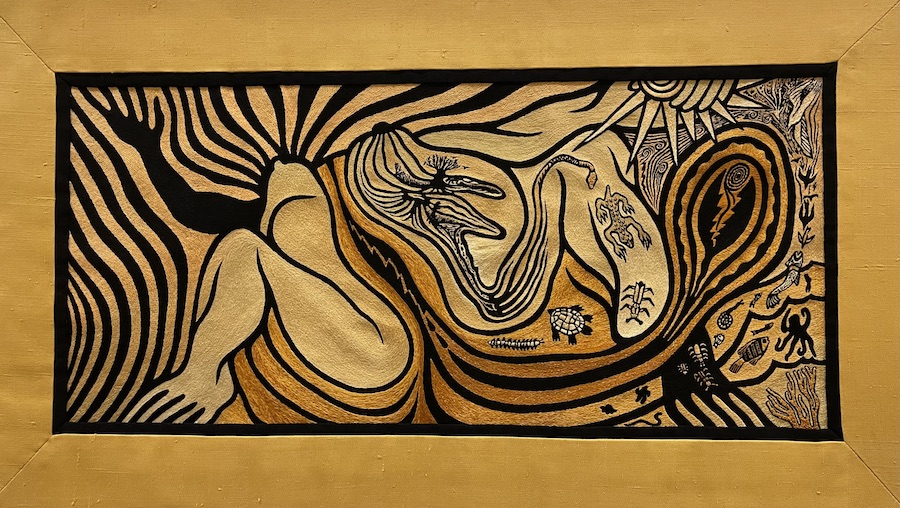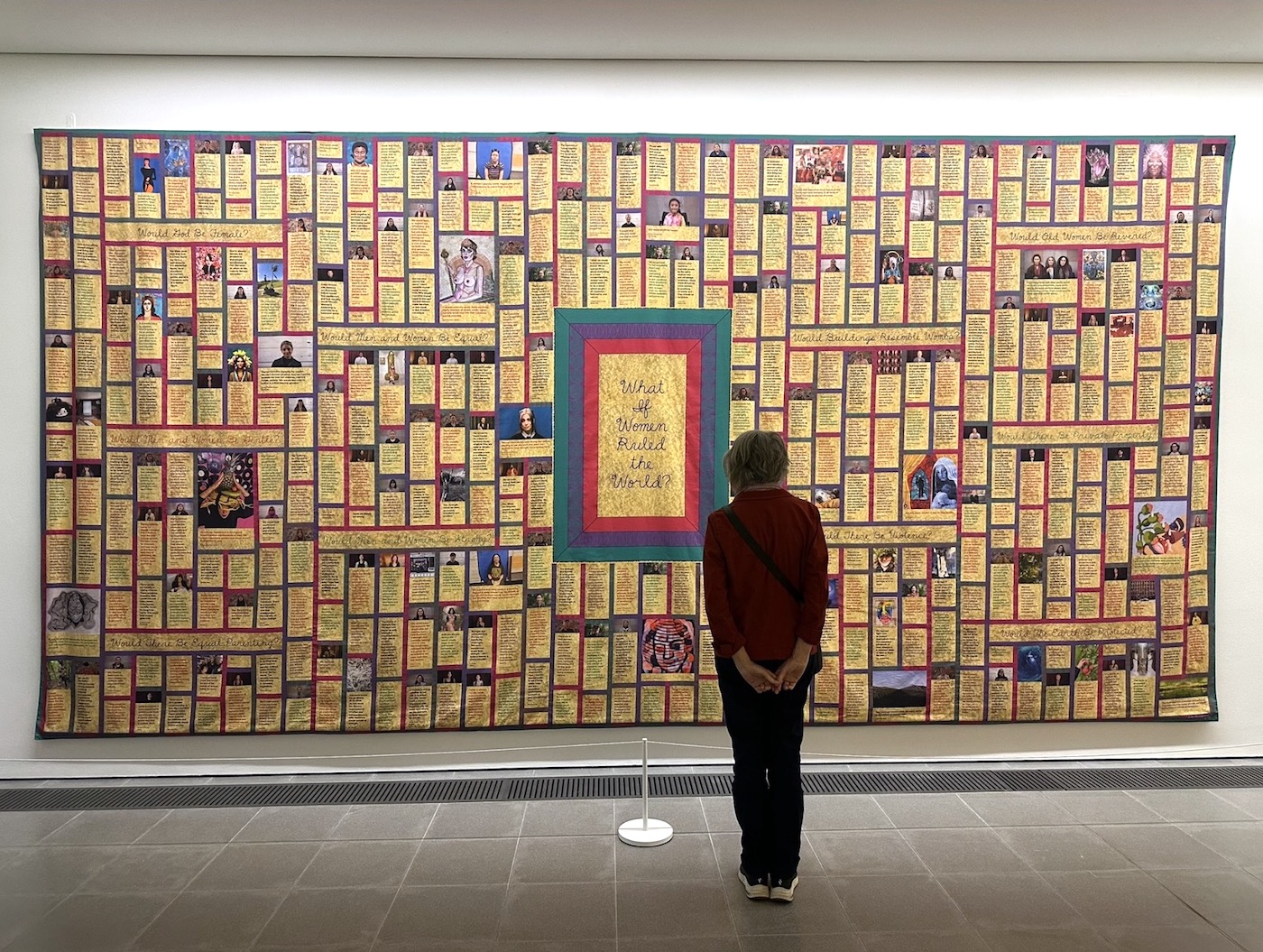Judy Chicago Revelations, Serpentine North Gallery 23 May 2024 – 01 September 2024: It was in 1948 that the scholar and poet, Robert Graves, published The White Goddess, an unorthodox work, part invention, part research into pre-Classical cults and religions that reframed mythology from a feminist premise. According to Graves, The White Goddess was the pinnacle of a matriarchal order disposed by the later patriarchal gods of classicism. She combined not only the powers of love and destruction but was also the muse of poetic inspiration. In the 60s and 70s, feminists adopted the image of the goddess in reaction against the Abrahamic, male-dominated religions. This identification with and veneration for the divine feminine allowed women to explore gender and what it meant to be female in new ways. It was a trope taken up by poets like Sylvia Plath, Marge Piercy and Judith Kazantzis, as well as artists such as Judy Chicago. Goddess feminism became the metaphor for the collective confrontation of the patriarchy and the ecological injustices and suffering it causes.
I first saw Judy Chicago’s The Dinner Party 1979 in a rundown warehouse in Islington. It was 1985, and I had only just started writing about art. I was a young poet, a single mother and had no degree in art history but was bowled over. I’d never seen anything like it, a bold, brave visual embodiment of the female experience. It seemed to speak to me directly. Arranged on a triangular banqueting table there were a total of thirty-nine place settings commemorating iconic women. Each hand-painted porcelain plate decorated with a central motif, part butterfly, part vulva. There were embroidered runners and gold chalices with the names of 999 other significant women. It remains the acme of Chicago’s work and, rightfully, has a permanent home in the Centre for Feminist Art at the Brooklyn Museum.
Now, some fifty years later, she has a major retrospective at Serpentine North entitled Revelations. The name of the exhibition is taken from an illuminated manuscript Chicago created in the early 1970s whilst simultaneously working on The Dinner Party.. For this show, the manuscript has been updated with new drawings published for the first time that draw on research into goddess worship and the retelling of creation myths from a feminist perspective. Organised thematically around five chapters, the exhibition focuses on drawing – the central practice in Chicago’s oeuvre – and moves clockwise around the gallery, tracing the artist’s career with previously unseen work that addresses birth and creation, masculinity, power and environmental extinction.

It is a strange experience to revisit this thinking. It’s not as if the issues she touches on are not still relevant – especially her concern with environmentalism – but that, in many ways, the imagery and language belong to another more innocent and committed century. Walking into the gallery, the viewer is confronted with a vast drawing, In the Beginning. It’s presented as a manifesto of sorts in its attempt to dismantle patriarchal structures by melding female forms of birthing with the earthly and the cosmic. Its luminous rainbow colours and fluid forms swirl across the wall like some enormous birth canal, spawning snails, newts and turtles among its fronds. In 1999, the critic Lucy Lippard noted in the Florida State University Art Museum’s exhibition catalogue that “Drawing is about beginnings…. about the layers of the creative process.” In the Beginning integrates texts in Chicago’s looping American script that say things like “Then from the chaos there emerged a sigh/ and the sigh became a moan/and this moan became a wail/ and this wail became a scream of birth.” Part One of the manuscript that gives form to the exhibition is entitled Revelations of the Goddess, a long exegesis of the creation myth from a feminist perspective. And yet? So very powerful at its inception some fifty years ago, in these more postmodernism, cynical times, it seems to smack of essentialism: woman as nature, woman as earth mother, as the great I AM. The very thing that women were attempting to escape.
The minimalist and abstract drawings from early in her career, such as Grey Fan #4 1970, are structured by a system of gradient-coloured boxes that fan out from a central slit that makes them appear to pulsate, to open and close. While works such as the Great Ladies Series 1973 use biomorphic forms to suggest and symbolise female sexuality (a nod to Georgia O’ Keeffe?). where vulvae become mandalas, mandalas vulvae.
In the section The Yearning, Chicago explores the male-dominated field of pyrotechnics with a series of site-specific performances known as Atmospheres. Smoke was used to ‘transcend conventional artistic boundaries’ and create ‘expansive’ drawings in a ‘gesture of liberation.’ Plumes of coloured smoke merge with the landscape, ‘mixing it with the wind, the air and the sky’ in response to the ‘male-dominated’ Land Art Movement. In Northwest Coast Atmospheres 1970-75 and Women and Smoke 1971-72, staged in the Californian desert, the pigment–covered naked bodies of the female performers suggest shamanic rituals with the use of fire that can be read as alchemical and transformative.
Born in 1939 to a Jewish family (her name was originally Cohen), Judy Chicago was an undergraduate at UCLA in the late 50s, the era in which the poet Plath also grew up torn between being the dutiful daughter, the good wife who baked cookies and a fierce poet. Chicago was led to believe, whilst a student, by one well-known professor, that women had made no contributions whatever to European art history. Her early work, along with other feminist artists of her generation, was a protest against this invisibility. More recently, she made a series of banners for Dior’s spring-summer haute couture collection 2020 that posed the question, What If Women Ruled the World? made in collaboration with the Pussy Riot founding member, Nadya Tolokonnikova. The exhibition at the Serpentine culminates in And God Created Life 2023, the most recent work that proposes a concept of God that is neither male nor female.
There is no doubt that Judy Chicago was a trailblazer of feminist art, a voice that demanded that women’s lives, bodies, and art were put centre stage after centuries of invisibility. In many ways, it might be argued that she’s done her job, but, looking back, the language of goddesses, birth and fire appear to belong to another, more innocent age when things were more binary and calling that out was seen as a big part of the solution. Nowadays the world seems an infinitely more complicated place.
Photos ©Artlyst 2024
Visit Here
Sue Hubbard is an award-winning poet, novelist and freelance critic. Her fourth novel Flatlands, from Pushkin Press can be bought here:Flatlands by Sue Hubbard | 9781911590743 | Pushkin Press. Her latest poetry collection God’s Little Artist: poems on the life of Gwen John
Buy Here

